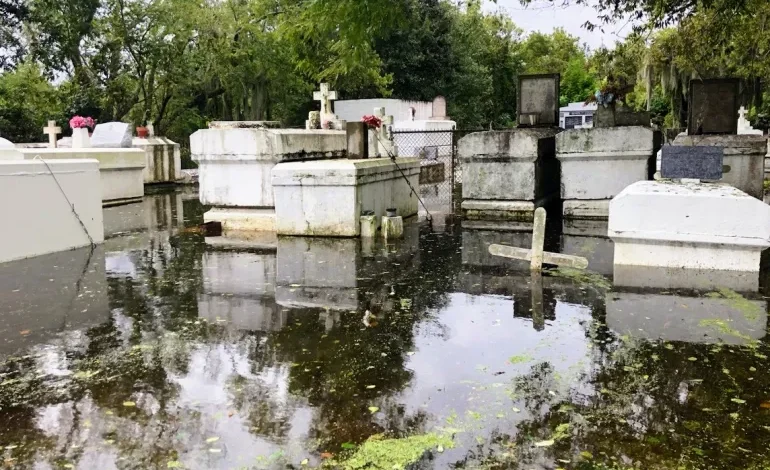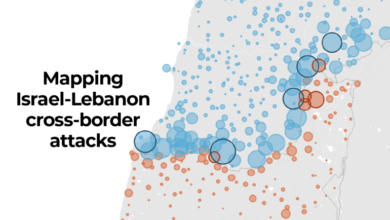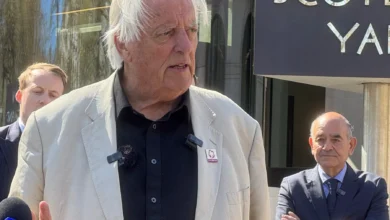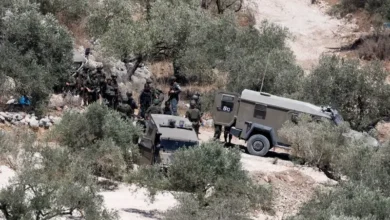As Louisiana’s coast washes away, the dead are the first to go

Down in Cameron Parish, a storm-wracked region low on the coast of the Gulf of Mexico, Patrick Hebert has a talent for finding the dead.
Since 2005, he has found hundreds of lost caskets – stuck on levees and fences, tangled in brush or half-buried in marsh mud.
He pulls them out of shallow lakes, drags them off dikes, and tows them to dry land along shipping channels.
It happens every time a hurricane hits this corner of southwestern Louisiana: The force of the storm surge – a wall of water up to 5 metres (17 feet) high, racing inland – rips the doors off mausoleums, tears vaults out of the soft ground, and floats caskets away, into the marsh. Sometimes, Hebert says, they travel for miles.
Hebert, a marshland contractor, sits in his office, clicking around the satellite view of Cameron Parish marshes using Google Earth. He reads the territory with an expert eye, pointing out low piles of earth that can become debris backstops and casket collection points. And then he zooms way in, pointing to a tiny hump of mud in the marsh that bears a small, grey rectangle: a metal casket, ripped from its grave by a hurricane. Hebert picked up the casket around January 2023, but it is still visible on these satellite images from 2022.
“This lady right here,” Hebert, 48, says, eyes on the screen, “her son was real distraught”. The woman in the casket had been buried in Grand Chenier, a tiny coastal town where her son, Mike, still lives. She had been washed from her grave during Hurricane Laura in August 2020. “He called me several times – ‘You haven’t found her yet? You haven’t found her yet?’ So, we had been looking for this one.”Hebert makes some quick calculations. “She went 3 miles [4.8km],” he says. “The water was high, maybe 10 feet [3 metres], so she just –” with a flat palm, he makes a floating gesture, then zips his hand off into the distance.
A couple of duck hunters had spotted the casket in the wetlands and given him a call to pick it up. Hebert and his helpers had taken an airboat out to the GPS coordinates the hunters sent and found it, flipped upside-down, on a tiny island of marsh grass peeking out of the brackish water: a faded blue-green casket capped by rust. It was heavy. The seal had broken, letting water in. They drilled holes in the casket, drained and lifted it; a messy job requiring brute strength. Finally, they got it in the boat, strapped it down, and headed back to more solid ground. A typical pickup; the kind they’ve now done hundreds of times.
But the problem of displaced caskets isn’t confined to Cameron Parish.
Since Hebert began picking up lost caskets almost two decades ago, the issue has only gotten worse. As the shoreline creeps closer, and hurricanes grow stronger, coastal communities across southern Louisiana are increasingly running into the same problem: The dead won’t stay put.‘I knew about half of them’
Collecting the lost dead isn’t Hebert’s job. Nobody pays him. But he does it, he says, because if he doesn’t – who will?He’s the only one around Cameron Parish equipped to do the work. That’s thanks to his fleet of airboats and marsh buggies – enormous amphibious vehicles that can both drive across wetlands and float on water, vehicles he normally uses to build levees throughout the parish, clear trails, and perform oil and gas pipeline repair work. There, in Louisiana’s largest and most sparsely populated parish, black-eyed alligators sun themselves along the roadside, and wildlife refuges teem with white egrets and snapping turtles. The parish’s towns sit on a ridge of highland along the Louisiana coast, the Gulf of Mexico laid out on one side, marsh on the other.
Hebert also takes on the task because this is his home. His own ancestors, dating back 180 years, are buried in the cemeteries here. The people he pulls from the marsh were friends, neighbours and family.
“I was related to a lot of those people,” says Hebert, a sturdy man with a neatly trimmed reddish beard and reading glasses tucked into his shirt collar. “I knew about half of them,” he estimates. He’s stepped outside his office and now leans on the hull of a red airboat at his headquarters in Bell City, a community of about 900 people north of Cameron Parish, on an overcast afternoon in March. “The other half, I’d know their family.”
If he didn’t do it, he says, he isn’t sure what would happen. He supposes they’d just be left to sit, decomposing in the marsh. Who, after all, is around to notice, to fight to rebury the dead? Few people, he says wryly, want to take care of his “little town” of Cameron – his hometown and namesake of the parish it sits in. “But I do.”
Hebert says he has periodically reached out for assistance to Louisiana’s statewide Cemetery Response Task Force, which helps families, contractors, and other applicants apply for funds from the Federal Emergency Management Agency (FEMA) and directs resources after a disaster in order to collect, identify, and reinter burials. He says he was repeatedly told the office was overwhelmed and understaffed. Once, when he applied through the Parish government to have some of his expenses reimbursed after Laura, it took more than a year to receive payment. A parish spokesperson told Al Jazeera they sent Hebert’s invoice to FEMA for reimbursement, but are still awaiting a decision and paid Hebert with the parish’s general funds in the meantime. Hebert is now a licensed contractor with the Governor’s Office of Homeland Security and Emergency Preparedness (GOHSEP), and so is paid for some of the work, like moving the caskets he has collected into trailers with a forklift so they can be brought to Baton Rouge, the Louisiana capital, for identification. The rest of the time, though, Hebert covers the costs himself – fuel, boat captain wages – to the tune of tens of thousands of dollars.Amber Hargroder, Communications Officer at the Louisiana Department of Justice, which provides the staff for the Task Force’s daily operations, acknowledged that the problem of disrupted cemeteries is often overlooked. But in response to questions about the work Hebert has taken on at his own expense, she said that since he is not a Task Force contractor and therefore doesn’t “follow proper procedure”, he is “putting the deceased at risk of harm, looting, and damage” and adds that his actions are “reckless and unwarranted”. She gave no indication, however, that other contractors have been brought on to do this work in Hebert’s stead.
Once Hebert learned a Task Force had been formed, he called its chairman, Assistant Attorney General Ryan Seidmann, to keep him “in the loop” about his casket finds. He says that Seidmann gave him some instructions – for example, Hebert should write GPS coordinates on the casket lid, showing where it was found – but was never asked to become an official contractor. He never pursued it: It didn’t even occur to him, largely because he’d been doing the work on his own for so long – over a decade before the Task Force was launched. He also finds the state’s slow pace frustrating.
When he has gone through official channels, it has taken weeks for approval from the Task Force to retrieve even a single casket. And casket retrieval after autumn storms must be done quickly: Once spring arrives the scattered caskets will be swallowed up by a riot of green vegetation, making them virtually impossible to spot.
While Hebert takes on the trouble of collecting the dead himself, it is the Task Force that must use 18-wheeler trucks to bring the caskets to Baton Rouge. And that typically means a long wait. At the back of his workshed, Mike’s mother is still waiting.
To demonstrate, Hebert walks through the garage’s buzz of power tools, past his crew busily doing maintenance on the vehicles, brandishing metre-long wrenches. He continues on, to the back of his storage area. And there, tucked behind a twin-engine fishing boat, sit two caskets.
One is empty, dug out of a drainage canal with its bottom rusted out. The remains, lost somewhere in the marsh, will never be recovered.
He gently places his hand on the lid of the other. This casket, resting on pieces of lumber and surrounded by old pallets and worn hoses, holds Mike’s mother, waiting, almost three years after she washed away, to be reburied.
Once Hebert brought her casket back to his shop last winter, he’d had to do one last grim piece of work. Mike had wanted him to double-check that it was really his mother.
So Hebert opened the lid. Inside was a short, stout woman. He snapped a photo of the dress print. He texted it to Mike.










